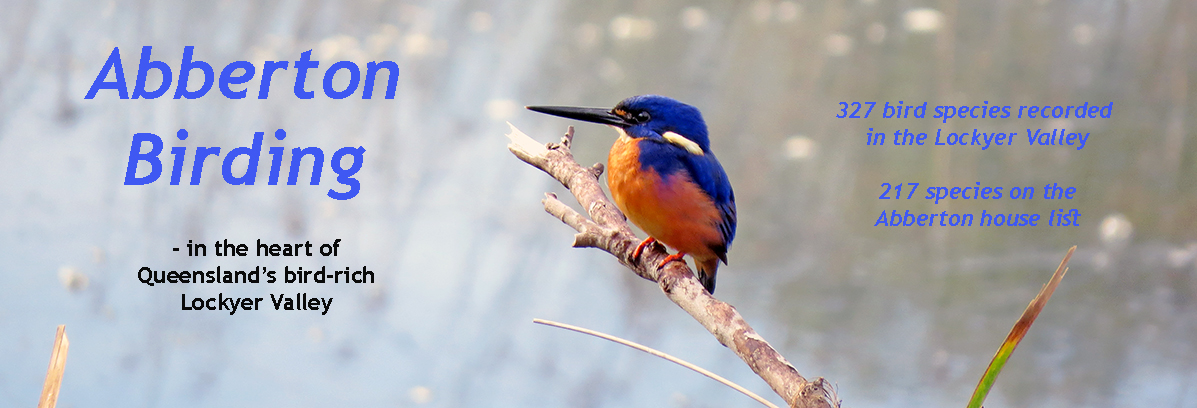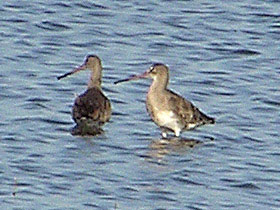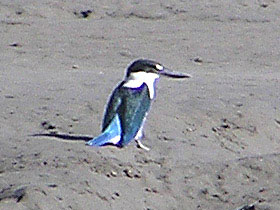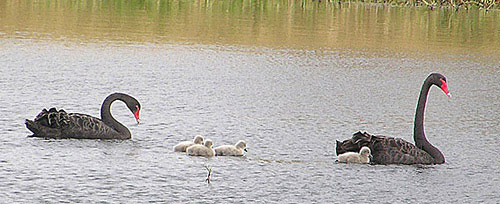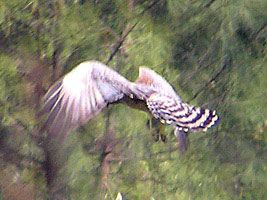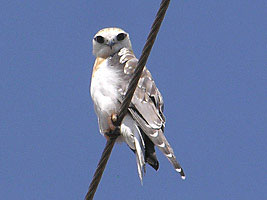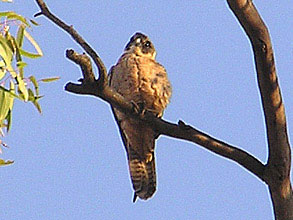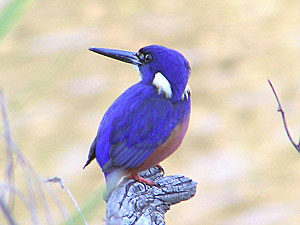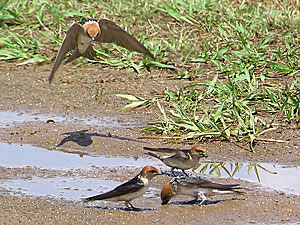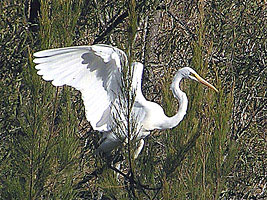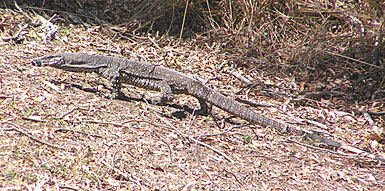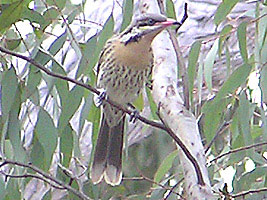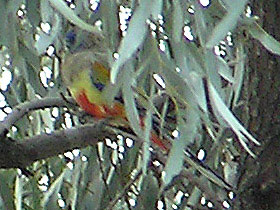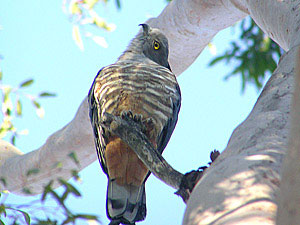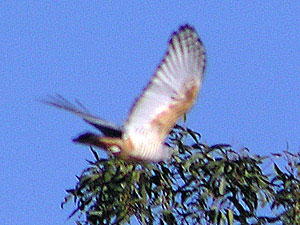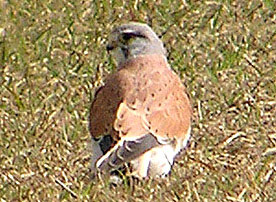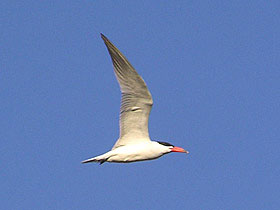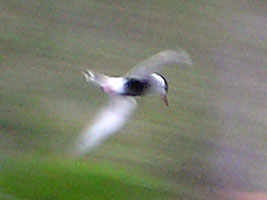December, 2004 - Black Bittern &
return of the Bush-hen>
Just as we got home from town late
this-afternoon, a Black Bittern rose from a small muddy patch across
the
creek from the house - a favourite shady resting place for various water
birds. Maybe it had spent hours there
while I was stuck in the shops!
It flew along the creek and out of sight, all in the space of maybe five to
ten seconds.
One of the very last birds of 2004 for us at Abberton. Our bird list for the
garden now stands at 205,
with 116 spp for this December being our highest monthly total to
date.
We were excited last year when a Bush-hen turned up at Abberton on 30
December, and called noisily
for the best part of two weeks, granting us occasional views. Quite a few
people got to hear that bird, and
a few friends even managed to see it. He was a new bird on our Abberton
list, and when he disappeared in
January we accepted that we'd been lucky enough to enjoy one of those
odd birding one-offs that happen from
time to time, and the Bush-hen wouldn't be seen or heard of again.
Then on Boxing Day this year, a Bush-hen began calling loudly from the
creek-bank right across from the house.
It started at about 6.45pm and it was still going strong around midnight -
I'm sure the Bush-hen was the last
sound I heard from my bed that night. Has the same bird returned? Has it
possibly been hereabouts all year,
but only just re-announced itself? There are so many possibilities to be
considered.
The very next day, when friends from a couple of
kilometres further up the creek came over, I played them the call.
"Oh yes", they said, "we've been hearing that at night!"
They are of course sworn to take their mobile phone
down to the creekbank and to call me as soon as they
next hear the call. I hope to be sitting on my verandah at the time,
listening to a different individual Bush-hen.
There is a small mystery to be solved, with the possibility of at least one
exciting scenario if we can confirm that
we have more than one individual calling here.

A Peaceful Dove basking before going
down to the pool
|

Meanwhile, Brown Honeyeater, Silvereye and
White-throated Honeyeater over at the bird bath
|
|
13
December 2004 - Talking of
Letter-winged Kites
There
have been a few reports of putative Letter-winged Kites in the area recently
- none of them satisfactorily confirmed.

Black-shouldered Kite
The
dark areas showing against the sky on the underwing of this hovering
Black-shouldered Kite perhaps illustrate
how it might be that people not familiar with either of these handsome
raptors could, having seen such a bird,
take a look later at a field guide and assume that they had seen a
Letter-winged Kite.
|

click image to enlarge
|
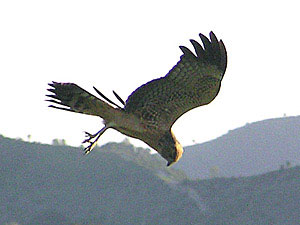
|
|
Local Spotted Harriers
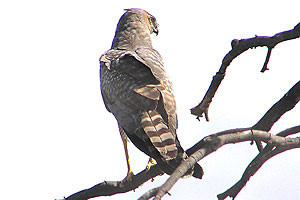
|
I've been trying my hand at in-flight photos lately. Not too hard with a
Whistling Kite,
but very much tougher to capture a fast-moving White-throated Needletail!
|
|
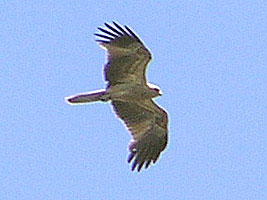
Whistling Kite
|
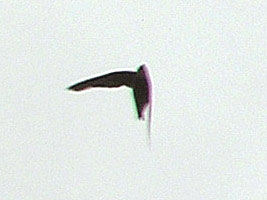
White-throated Needletail
|
|
|
|
9
December 2004 - Painted Snipe on
the Move
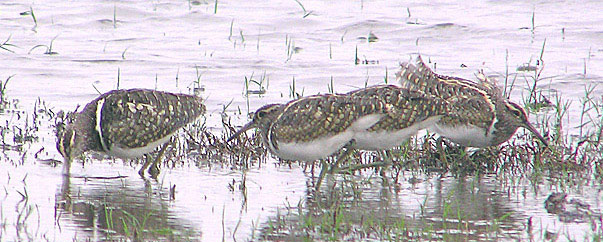
Painted
Snipe at Lake Atkinson on 7 November, 2004
I
haven't seen the Painted Snipe at Lake Atkinson for some time now, but have
heard of a single male or
immature bird near at Gatton on 23 November, and on 3 December I found
2 juveniles
alongside a small waterhole near Seven Mile Lagoon.
All
of these birds could well be from the family that was at Lake Atkinson in
November.
|

click image to enlarge
|
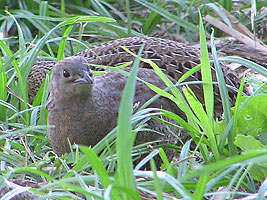 |
|
Brown Quail in the garden
Brown Quail are always around, but just
lately two birds have taken to feeding
close up to the house every day.
|
|

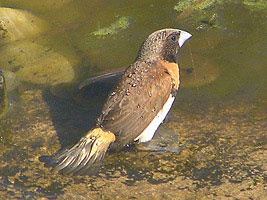
Female Common Koel and Chestnut-breasted
Mannikin at the rock pool.
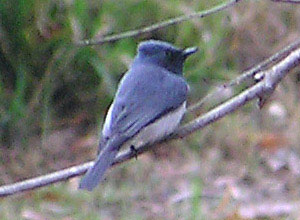
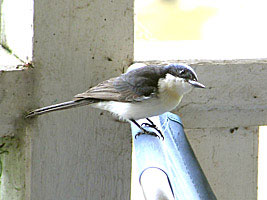
Leaden Flycatcher in the garden and Restless
Flycatcher on the verandah.
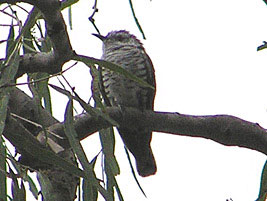
Little Bronze-cuckoo
We hear Little Bronze-cuckoos more than we
see them. This one has been around for weeks now,
but has still not allowed me close enough for a good photograph.
|
|
30
November, 2004 - Rain!
We've had some decent rain at
last, and there is water again in some of the long-dry lagoons.
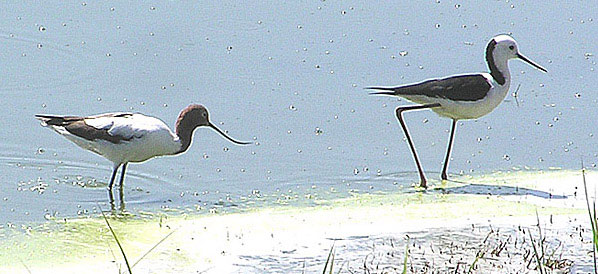
Red-necked Avocet and Black-winged Stilt -
both are breeding locally

Buff-banded Rails get quite adventurous
following rain
|
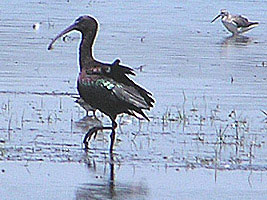
Glossy Ibis and Marsh Sandpiper
|
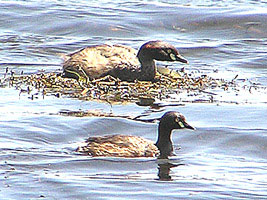
Australasian Grebes at the nest
|
|

The Pacific Black Duck is a beautiful bird
- and ill-named

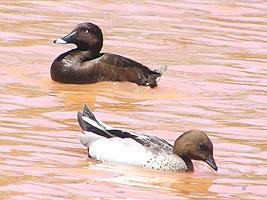
Hardhead and Australian Wood Duck
|
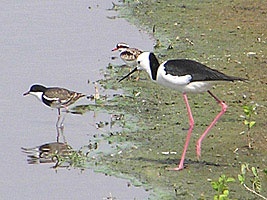
Red-kneed Dotterel, Black-fronted
Dotterel
and Black-winged Stilt
|

Red-kneed Dotterel
|
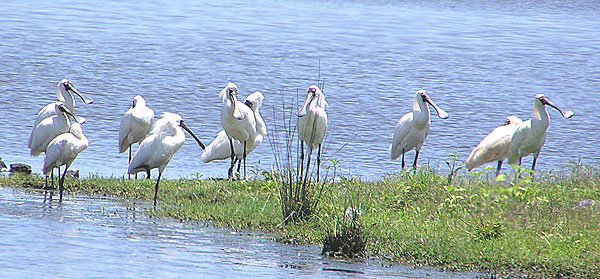
Royal Spoonbills
|
|
15
November 2004
- Birds 204 and 205 for Abberton!
Two
new birds for Abberton in the space of a week:
Little
Grassbird, skulking in the creekside vegetation on 5 November, but
showing well as it
crossed
the creek; seen again the next day in the same place.
Fuscous Honeyeater. Not an uncommon bird a couple of kilometres away where
the soil and the
endemic
trees are just a little bit different, but the first one ever in our garden
on 11 November.
Seen
again by Eileen in a birdbath the next day.
|
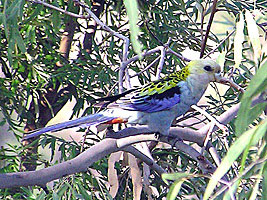
click image to enlarge
|
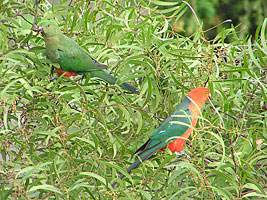
click image to enlarge
|
|
In
the garden:
Above
- Pale-headed Rosella and King Parrots
Below
- Red-capped Robin (in August)

Also
a new frog for us: Broad-palmed (Rocket) Frog. Several calling very noisily
just on dusk lately,
one
of which I was able to isolate and photograph - but the increasingly
frenetic call is a dead give-away.

Broad-palmed
Rocket Frog
|
|
9
November, 2004 - Inland a little
A
day just a little west of here, across the Great Dividing Range, delivered a
variety of more
inland species
- including Emu and White-winged Fairy-wren as well as a host of
different honeyeaters and much more.
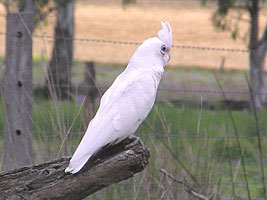
Little Corella
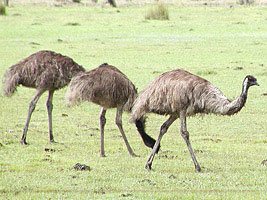
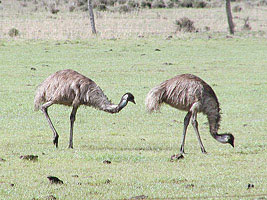
Emu

White-winged Fairy-wren
|
|
7
November 2004
- Painted Snipe, Musk Duck, possible Letter-winged Kite

Twenty
days after the first sighting, I got this photograph
of the three young Painted Snipe
which
are now just about the size of the accompanying male. Since then, I've been
back a couple of
times
without
finding the birds, which might well
have moved on.
A
fully-lobed male Musk Duck is at Lake Dyer, also a Great-crested Grebe.
I've
recently had two reports of Letter-winged Kites in the east of the state
from two
usually reliable
observers. The first was a couple of weeks ago, but was even then several
days old, and a bit distant,
and I couldn't follow it up, but the second was on Sunday near Lake
Atkinson. I did get out there and
didn't
see the bird, but I'm very much on standby. I feel that two reports so close
together from usually
reliable people merits thinking about, so if you're in
SE Qld - just give every Black-shouldered Kite
a
second look, in case.
|
|
7 November 2004
- Black Falcon
|
|

Black Falcon overhead
I've been seeing Black Falcons quite
frequently lately and suspect they might be breeding nearby.
I was able to pull off a few silhouetted
shots of this big falcon, which give some idea of its
characteristic jizz in flight with long broad, pointed wings and long tail.

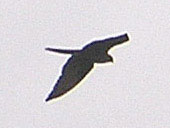
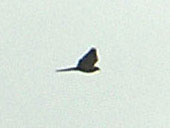
Black Falcon cruising
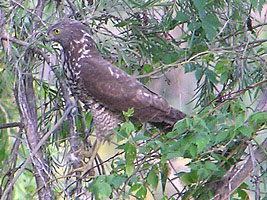
Immature Collared Sparrowhawk partaking of a
Double-barred Finch
|
|
25 October
2004 - A
garden full of birds
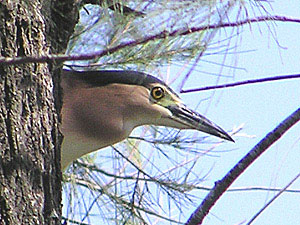
Nankeen Night-heron trying not to be
photographed
Following a
few days of rain, life in the garden is generally abundant. Several Nankeen
Night-herons are
roosting in creekside casuarinas and coming down to the water's edge at dusk
each evening.
Pheasant Coucals are calling noisily to each other for much of the day from
the lush vegetation they inhabit,
occasionally clambering up to show themselves in their rich rufous-brown and black
breeding plumage.
Rainbow,
Scaly-breasted and Little Lorikeets are coming to the eucalypts to feast on
the blossom. Many passerine species are nesting and taking advantage of the
plentiful supply of insects and other invertebrates
that are so plentiful in
the spring.
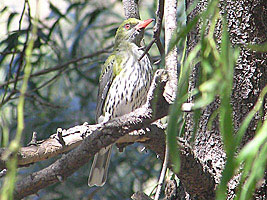
Olive-backed Oriole
click image to enlarge
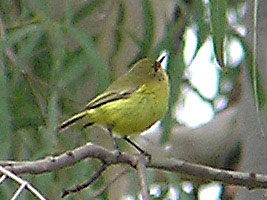

Yellow Thornbill
White-browed Scrubwren
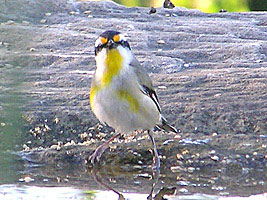
Striated Pardalote
click image to enlarge
The four species
above are all nesting at Abberton at present.
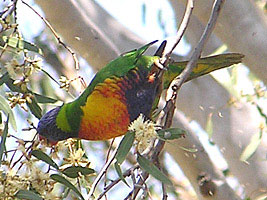
Rainbow Lorikeet, feeding on Eucalyptus tereticornis
|
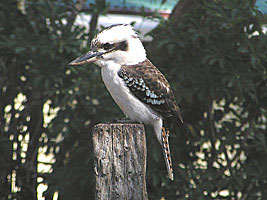 |
 |
|
Laughing Kookaburras and Red-browed Finches
are ever-present
|

Rufous Fantail (above)
and Spangled Drongo (right)
are seasonal visitors, both here now |
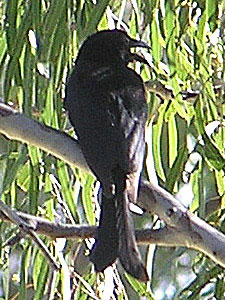
|
|
|
|
|
|
20 October
2004 - Painted Snipe and a lot more on a wet day
We've had a Little Bronze-cuckoo calling for several days, and on Sunday
morning it spent a spell in the trees close to the house allowing decent views and good looks at its red eye, but staying just a bit too high and too
back-lit for anything better than ordinary photographs.

Bush Stone-curlew
Monday was a day of awful weather here. Torrential rain, with intermittent spells of damp half-light. But once committed to a day's birding, it's hard
to stop - even the toughest day will surely yield some reward for
perseverance. We found Toowoomba's suburban Bush Stone-curlew early on, and
headed straight back down-range out of the cloud.
|
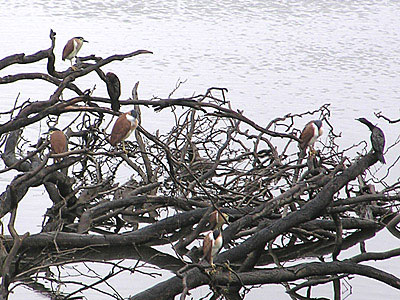
Some of the 10 Nankeen Night-herons which were on this tree
- with a couple of Little Black Cormorants |
In between drying lenses and sheltering from the worst of the weather we saw
ten duck spp on the
lagoons around the valley, and Lockyer Creek yielded 10 Nankeen Night-herons standing along the
branches of just one fallen tree! All full-plumaged adults.
As we were counting them, a Black Bittern flew past the night-herons and settled just upstream on another
fallen log. We saw another 5 night-herons during the day at other locations.
It was however just the right sort of day for crakes, and we had long looks
at a Baillon's Crake,
walking and swimming.

Australasian Shoveler
|
|
|
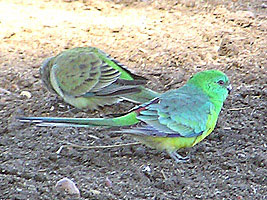
Female and male Red-rumped Parrot,
part of a flock of 30 |

Eight Brown Quail were quietly feeding just inside the gate
as I got home the other day |
|
Later, a flock of 30+ Red-rumped Parrots, also 3
Ground Cuckoo-shrikes harassing a magpie, then resting on
a branch just over our heads, close enough for us to enjoy the beautifully fine barring across
what usually just shows only as a pale rump.
Late in the afternoon, (in almost impossible
light for photographs) we came across a Painted Snipe with three
tiny young. Yet another location
for Painted Snipe, which we've seen now at eight or nine spots around
the
Lockyer Valley in recent years.
|



Painted Snipe with three young, all
looking pretty small alongside Black-winged Stilts.
Note the young birds swimming in the second photograph, and in the third, a
straggler being
severely harassed by a Black-winged Stilt. The youngster
made it safely back to the group.
|
|
|
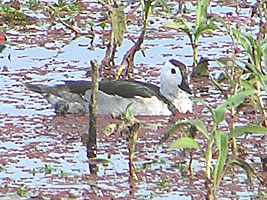
click image to enlarge
|
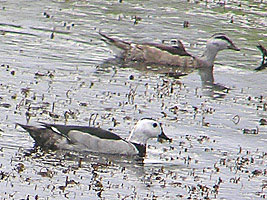
|
Cotton Pygmy-geese, female with the dark stripe through
the eye.
|
The next day, we found Cotton Pygmy-geese on three different bodies of water,
and
two immaculate Hoary-headed Grebes - which always remind me of a smart Spanish Don
with his salt-and-pepper hair brilliantined and slicked straight back.
|
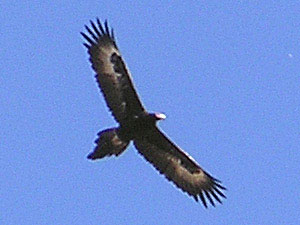
Wedge-tailed
Eagle
|

Spotted Harrier
|
|
Spotted Harrier hunting the creekside paddocks, Wedge-tailed Eagles, more night-herons, including one
right in front of the verandah on a post which had just been vacated by an Azure Kingfisher.
Multiple Rainbow Bee-eaters nesting in the banks of Lockyer Creek.

Nankeen Night-heron on a post in the creek,
opposite the verandah
Collared Sparrowhawk at Abberton this-morning, and Speckled Warblers, which have been wandering
about with good-sized juveniles seem to be gathering nesting material
- maybe they're going to go have another go.
|
|
6 October 2004 - Spotted
Harriers
I met a pair of Spotted Harriers yesterday afternoon,
just up the road. They were communicating noisily, and one had a half-eaten
catch in its talons with which it flew around, calling all the time, while
the other sat in a tree.
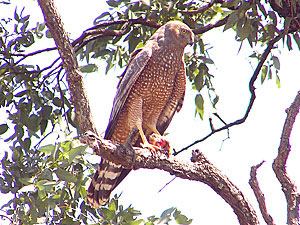
Spotted Harrier with half-eaten prey
click image to enlarge
When the bird with the prey landed, I managed this
snap. What a magnificent raptor!
|
|
24
September 2004 - What a day!
120 + species yesterday around the valley, and we didn't get
round to any forest before we ran out of light!
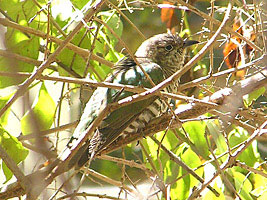
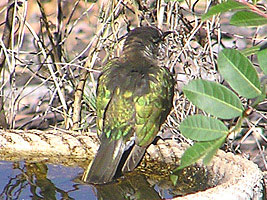
This Shining Bronze-cuckoo
has been in the garden for a week or so.
At home, we've had a pair of Shining Bronze-cuckoos hanging around for a
couple of weeks now,
they've even started coming to the bird baths. They've got a good supply of potential hosts with
Yellow Thornbills, Weebills, White-throated Gerygones and all the fairywrens nesting, as is much
else including Fairy Martins, Olive-backed Orioles, and several finch spp.

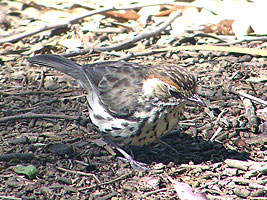
Speckled Warbler male, and female with the chestnut stripe above the
eye
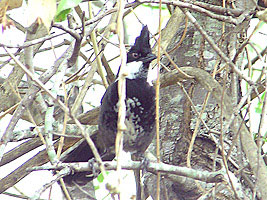
Eastern Whipbird, a regular in the garden
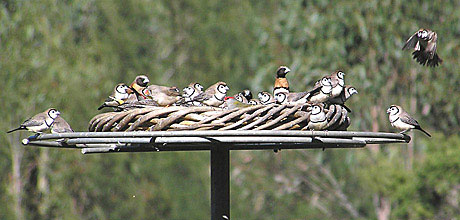
Assorted finches at the feeder.
I only put out one cup of seed a day - but they all turn up for it.
click image to enlarge
Speckled Warblers have got two youngsters and Chestnut-breasted Mannikins have got young in
tow. There are pairs and pairs of Rainbow Bee-eaters all over the place.

Sacred Kingfisher in residence
Channel-billed Cuckoos turned up here at Abberton yesterday
and Sacred Kingfishers, which never leave for long, are back and very noisy. |
|
|
|

Red-capped Plovers
Sharp-tailed Sandpipers and Marsh Sandpipers are now present at several
waterside locations, along with Red-capped Plovers and one or two Pacific
Golden Plovers.
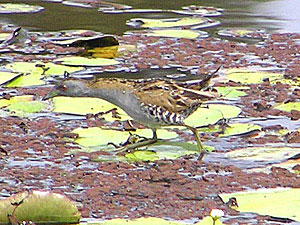
A local Baillon's Crake went walkabout in the open in the middle of the
day
|

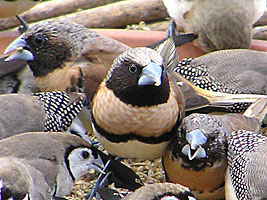
Australian King Parrots, Chestnut-breasted Mannikins and
Double-barred Finches
|
In the garden this-morning, we had White-backed Swallows flying low over our
heads.
The Shining Bronze-cuckoos were getting around together, though they sometimes sit quietly in partial
cover - apart, but in the same tree. Some big Eucalyptus tereticornis are just beginning to burst into flower,
and are
full of Scarlet and other honeyeaters, pardalotes, thornbills, whistlers and
gerygones.
These are the trees that Black Honeyeaters turned up in one
October while they were flowering
- so every small bird up there is getting a thorough inspection, in case it happens again.
|

click image to enlarge
|
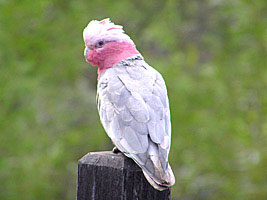
|
|
A beautiful Crested Pigeon - and just a couple of feet
away a Galah on a verandah post
|
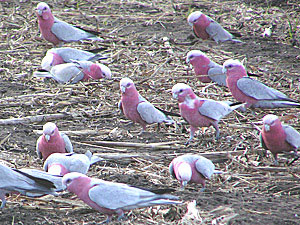
Galahs feeding their way through a field of
stubble
|
|
1 April
2004 - Channel-billed Cuckoos still here.
But, firstly, hot from the
camera - here are a few photographs taken just this-afternoon in the garden at Abberton.
|
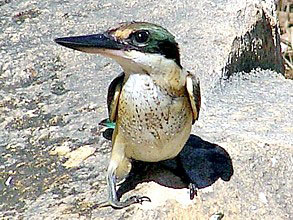
A juvenile Sacred Kingfisher who is coming for a wash in our rock-pool every day....
|
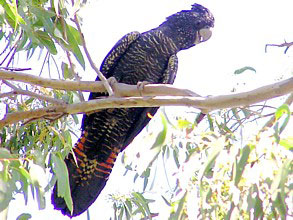 |
 |
|
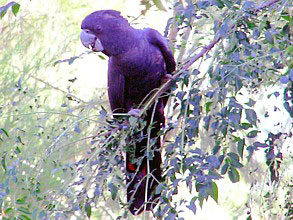
|
and a female Red-tailed Black Cockatoo in a
Eucalyptus, and a male in a White Cedar
- part of a group that spent most of the day in our garden eating the fruit
of the cedars....
|
|
|
|
Back
to the Cuckoos -
Charadriiformes apart, it's surprising how
few species actually absent themselves from Australia in toto
in the winter. Most of our cuckoo species just relocate within Australia,
only the Oriental Cuckoo,
Channel-billed Cuckoo and Common Koel departing our shores more or less
en-masse. Similarly with the Coraciiformes, only the Buff-breasted Paradise
Kingfisher and the Dollarbird exit the country
completely. Likewise White-throated Needletail and Fork-tailed Swift.
Having said which, there are occasional
winter records from north Queensland of most of the above species.

Juvenile Channel-billed Cuckoo - significantly bigger than
the Torresian Crows which are feeding it.
We
still have two juvenile Channel-billed Cuckoos in the garden every day,
making noisy demands on,
and being fed by, Torresian Crows. They've been stocking-up here since
February, but they must surely
be on their way north any day now.
Juvenile
Dollarbirds were here up to a week or so ago, Koels have now gone, whereas
Pheasant Coucals are
active, noisy and nesting. A lot of birds are breeding after the recent
rains, including Cotton Pygmy-geese and
Wandering Whistling Ducks at local lagoons, and very busy and vociferous
Eastern Whipbirds in the garden.
|
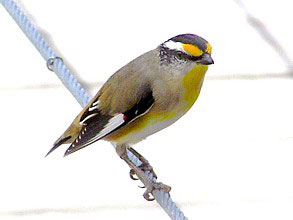 |
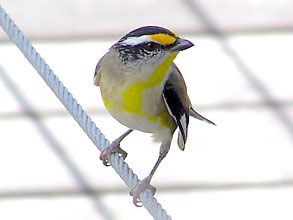
click image to enlarge |
Striated Pardalotes have recommenced their
distinctive, day-long, calling this last week or so. This one turned up on
the verandah just outside my study window, and the photo just had to be
taken, albeit through not particularly clean glass.
|
There has been some discussion on the
birding-aus mailing list about the difficulty of seeing Owlet
Nightjars,
which contrasts with their generally accepted abundance in the bush at
night. "Difficult to see, and still more
difficult to photograph"
was the consensus - whereupon I foolishly observed that I had photographed
one a
couple of years back, and volunteered to put it on the website.

Owlet Nightjar, just after dark.
Well,
here it is! And the poor quality of the image perhaps confirms how difficult
they are to photograph,
unless you can stake out a roost hollow.
|
|
Late March
2004 - A new pool for the birds.
|

A corner of the house, showing the study
window overlooking the new rock-pool. |
I've been
looking for some time for a sizeable piece of local sandstone that I could turn into a 'natural' birdbath,
and we've just recently installed a 2 tonne rock just outside my study window.
It will take some time for a newly planted native-garden to grow around the rock, but
it's already proving
popular with birds drinking or bathing in it every day
- at least 20 species so far.
|
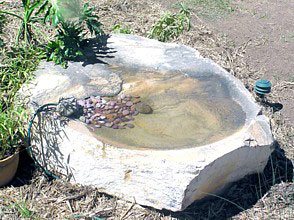 |

click image to enlarge |
The new rock from my window - and two
Plum-headed Finches visiting it, and below
a bedraggled Striped Honeyeater and Sacred
Kingfisher - both regulars at the new pool.
|

|
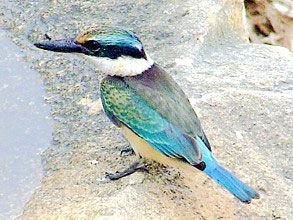 |
|
|
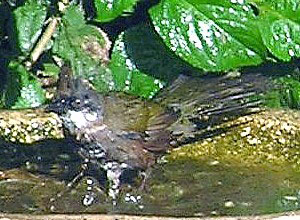
Eastern Whipbird bathing.
Despite the popularity of the new pool, the
older birdbaths remain busy. Eastern Whipbirds are very active just now,
with a male and female harmonising noisily in the undergrowth day-long, and
occasionally bathing together.
|
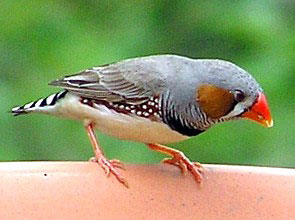 |
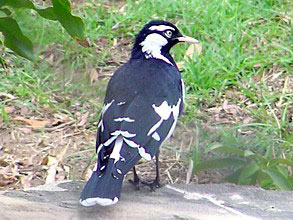 |
Four more of our residents -
above, Zebra Finch, Australian Magpie-lark
below: Double-barred Finch, Red-browed Finch
|
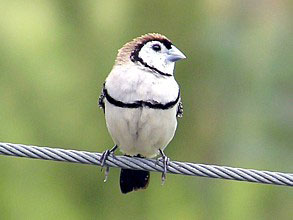
click image to enlarge |
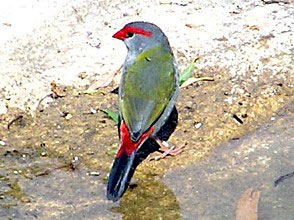 |
|
|
March,
2004 - A great start to Autumn.
Four years ago, we began revegetating Abberton's creekside and adjacent areas with locally native
species.
We dotted fifty or so White Cedars throughout the plantings, hoping
to provide an irresistible harvest
of fruit for the Red-tailed Black Cockatoos that are around most months, but
have never had
a food
supply in our garden. This year, the cedars fruited for the first
time, and the other day.......
|
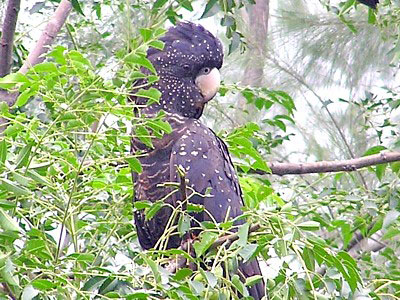
|
|
Female Red-tailed Black Cockatoo in a
fruiting White Cedar tree |
... a group of five Red-tailed Black Cockatoos
spent the best part of a day feasting in one White Cedar
in the garden. Since then, we've had them here every day, visiting various
cedars and also feeding
occasionally on gum nuts in interspersed eucalypts.
|
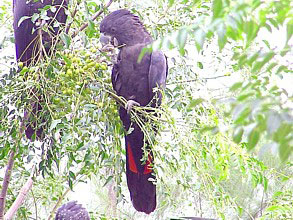 |
 |
|
Male and female red-tailed Black Cockatoos
enjoying the fruit of a White Cedar. |
|
Water has returned to many of the lakes that
have been low for so long, and even the ephemeral lagoons that have served
as grazing paddocks for the last few years now have water, and associated
waterlife, in them.
|
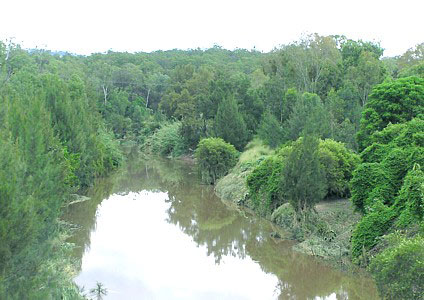
Lockyer Creek at Abberton. Our garden is
what you see on the right-hand side of the creek.
|
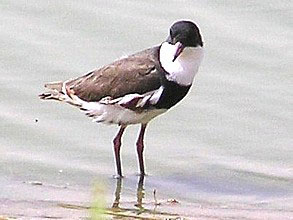 |
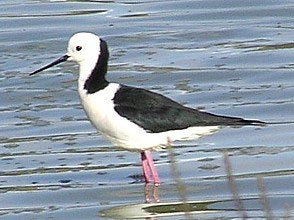 |
|
Red-kneed Dotterel and Black-winged Stilts
both have young at present. |
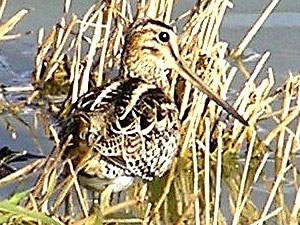
Latham's Snipe is a summer visitor
here from Japan.
|
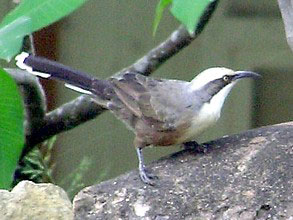 |
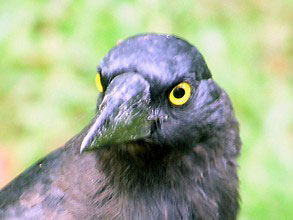 |
|
Grey-crowned Babblers are chatty, convivial
birds - colloquially known as "Happy Families". |
Pied Currawong, an omnivorous
species,
much given to nest-robbing. |
|
|
February,
2004 - After the heat.
Summer is just about over, but we still
have two Channel-billed Cuckoos serenading (!) us all day every day as they
make constant demands on the four Torresian Crows which are attending them. It
is probably just two sets of foster-parents with one usurper each, but they're
spending their days as a party, with the two young cuckoos mostly in the same
tree while the four crows forage constantly on their behalf.
|
|

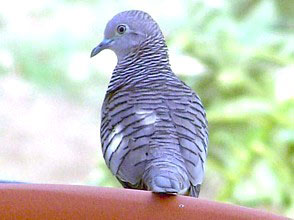
|
|
Two views of a Peaceful Dove, handsome from
any angle.
|
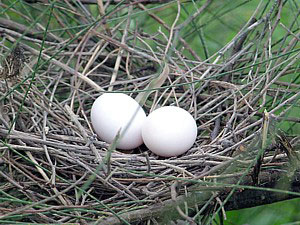
|
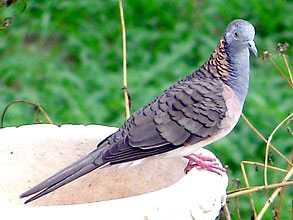
click image to enlarge
|
|
Bar-shouldered Doves nest here every year -
this one in a casuarina.
|
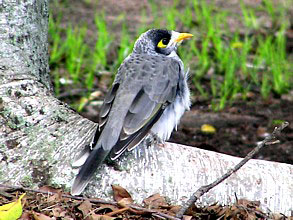
|
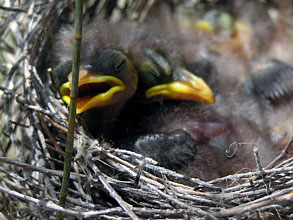
|
Noisy Miners are nesting nearby. We see
them only occasionally at Abberton, which suits us well,
because this aggressive species can easily
dominate a habitat.
|
|
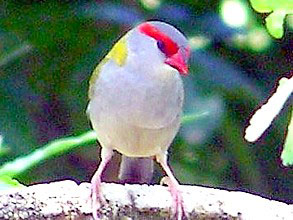
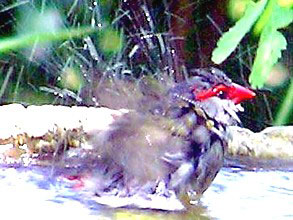
Several days of high temperatures resulted in a lot of activity at our bird-baths.
It's amazing how a bird as
smart as this Red-browed Finch can be transformed by a few
seconds of
bathing into something barely recognisable.
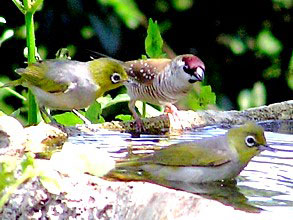
Plum-headed Finches and Silvereyes queuing
for a turn in the water.
|
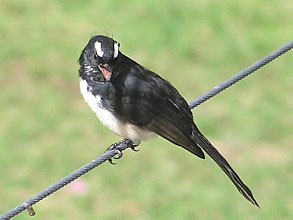
click image to enlarge
Willie Wagtail on the verandah, scolding me.
|
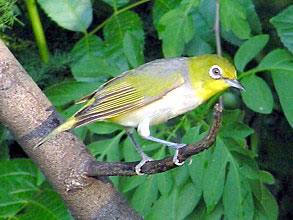
click image to enlarge
A Silvereye about to take the plunge.
|
|
These two beautiful birds are everyday species here, and
well worth a closer look.
|
|
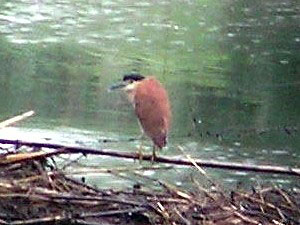
Nankeen Night-herons come to the creek to
forage every evening.
They have various roosting spots nearby, and
it isn't unusual to see a brightly rufous
adult bird flying along the creek in the middle of the day.
|

click image to enlarge
|
